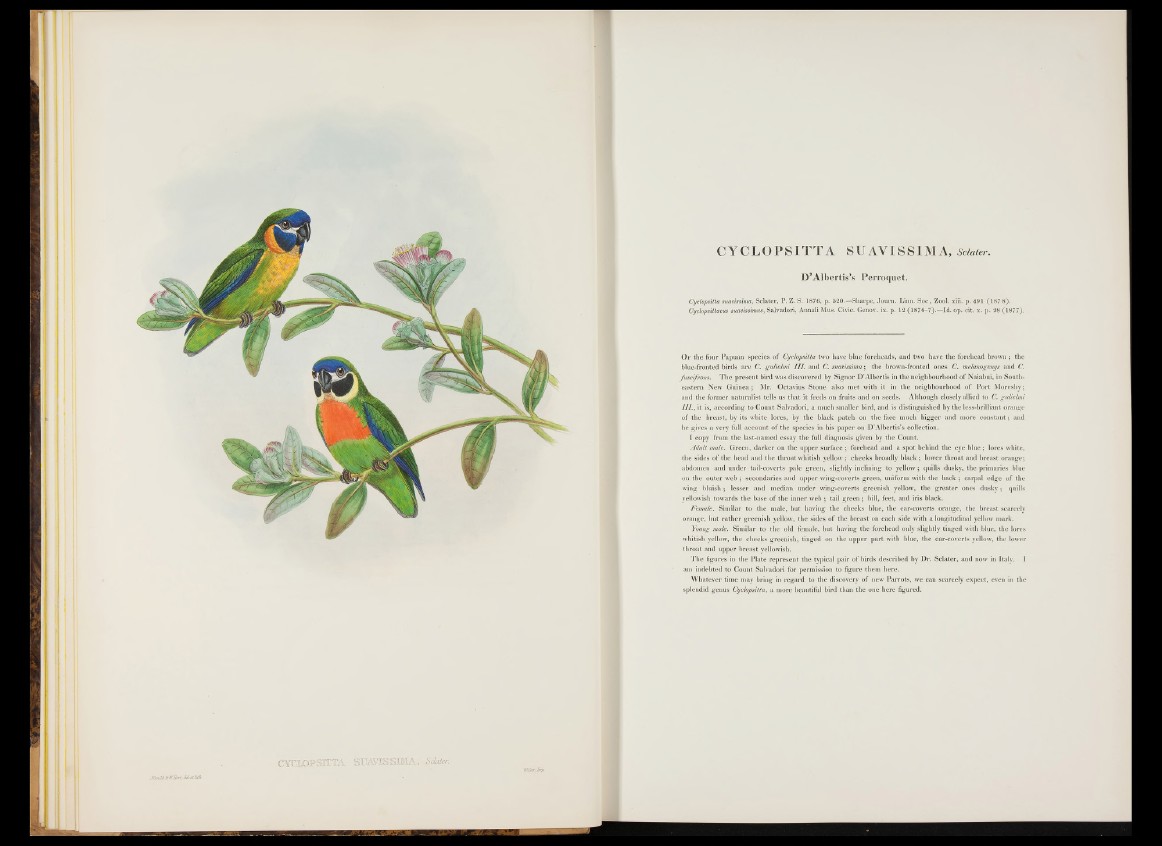
CYCXOlPSHm STMMSSIMA, §ckter.
JGouU'&KHarc. SeLctbtfv
CYCLOPSITTA SUAVISS1MA, Sclater,
D* Albertis \s Perroquet.
Cyclopsitta suavissima, Sclater, P. Z. S. 1876, p. 520.—Sharpe, Journ. Linn. Soc., Zool. xiii. p. 491 (187 8).
Cyclopsittacus suavissimus, Salvadori, Annali Mus. Civic. Genov, ix. p. 12 (1876-7).—Id. op. cit. x. p. 28 (1877).
O f the four Papuan species o f Cyclopsitta two have blue foreheads, and two have the forehead brown ; the
blue-fronted birds are C. gulielmi I I I . and C. suavissima; the brown-fronted ones C. melanogenys and C.
fuscifrons. T h e present bird was discovered by Signor D ’Albertis in the neighbourhood of N aiabui, in Southeastern
New G u in e a ; Mr. Octavius Stone also met vyith it in the neighbourhood o f Po rt Moresby;
And the former naturalist tells us that it feeds on fruits and on seeds. Although closely allied to C. gulielmi
I I I ., it is, according to Count Salvadori, a much smaller bird, and is distinguished by the less-brilliant orange
o f the breast, by its white lores, by the black patch on the face much bigger and more constant ; and
he gives a very full account o f the species in his paper on D ’Albertis’s collection.
I copy from the last-named essay the full diagnosis given by the Count.
Adult male. Green, darker on the upper surface ; forehead and a spot behind the eye b lu e ; lores white,
the sides o f the head and the throat whitish yellow; cheeks broadly black; lower throat and breast orange;
abdomen and under tail-coverts pale green, slightly inclining to yellow; quills dusky, the primaries blue
on the outer web ; secondaries and upper wing-coverts green, uniform with the back ; carpal edge o f the
wing bluish ; lesser and median under wing-coverts greenish yellow, the greater ones d usky; quills
yellowish towards the base o f the inner web ; tail g r e e n ; bill, feet, and iris black.
Female. Similar to the male, but having the cheeks blue, the ear-coverts orange, the breast scarcely
orange, but rath er greenish yellow, the sides o f the breast on each side with a longitudinal yellow mark.
Young male. Similar to the old female, but having the forehead only slightly tinged with blue, the lores
whitish yellow, the cheeks greenish, tinged on the upper part with blue, the ear-coverts yellow, the lower
throat and upper breast yellowish.
The figures in the Plate represent the typical pair o f birds described by Dr. Sclater, and now in Italy. I
am indebted to Count Salvadori for permission to figure them here.
Whatever time may briug in regard to the discovery o f new Parrots, we can scarcely expect, even in the
splendid genus Cyclopsitta, a more beautiful bird than the one here figured.